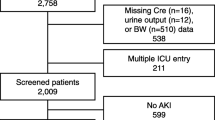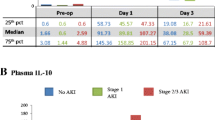Key summary points
To investigate whether inflammatory factors are predictors of acute kidney injury (AKI) in older people in the intensive care unit (ICU).
AbstractSection FindingsPlasma inflammatory contents of IL-6 and IL-8 can predict AKI in older people. Management of inflammatory factors should take into consideration the age of AKI patients.
AbstractSection MessagePlasma inflammatory factors in older people predict acute kidney injury.
Abstract
Purpose
To investigate whether inflammatory factors are predictors of acute kidney injury (AKI) in older people in the intensive care unit (ICU).
Methods
We performed a case–control study that included 98 older people (≥ 65 years) who were admitted to ICU from 2013 to 2017. The contents of plasma pro-inflammatory factors [interleukin (IL)-1b, IL-6, IL-8, tumor necrosis factor-a (TNF-α)] and the anti-inflammatory factor IL-10 were determined at the first day of admission. Patients were assessed based on the Kidney Disease Improving Global Outcomes (KDIGO) criteria and were divided into AKI and non-AKI (control) groups (n = 49 for each). T test was applied for differences comparisons in the levels of inflammatory factors between the two groups. Logistic regression was used to identify independent predictors of AKI.
Results
AKI patients had significantly elevated plasma contents of IL-6, IL-8 and IL-10, relative to the control group. A strong correlation was observed between IL-6 and IL-8 with AKI (OR 36.4 and 18.2, respectively). For each increase in the natural log unit in the levels of IL-6 and IL-8, the risk of developing AKI augmented by 36.4% and 18.2%, respectively. Moreover, the higher the tertile value of IL-6 and IL-8, the higher the risk of developing AKI. The area under the receiver operating characteristic curve for IL-6 and IL-8 was, respectively, 87% and 83% for predicting AKI.
Conclusion
Plasma inflammatory contents of IL-6 and IL-8 can predict AKI in older people. Management of inflammatory factors should take into consideration the age of AKI patients.



Similar content being viewed by others
References
Thomas ME, Blaine C, Dawnay A et al (2015) The definition of acute kidney injury and its use in practice. Kidney Int 87:62–73
Chao CT, Tsai HB, Lin YF et al (2014) Acute kidney injury in the elderly: only the tip of the iceberg. J Clin Gerontol Geriatr 5:7–12
Chronopoulos A, Rosner MH, Cruz DN et al (2010) Acute kidney injury in elderly intensive care patients: a review. Intensive Care Med 36:1454–1464
Kayatas K, Sahin G, Tepe M et al (2014) Acute kidney injury in the elderly hospitalized patients. Ren Fail 36:1273–1277
Chao CT, Tsai HB, Wu CY et al (2015) The severity of initial acute kidney injury at admission of geriatric patients significantly correlates with subsequent in-hospital complications. Sci Rep 5:1392–1395
Chao CT, Tsai HB, Wu CY et al (2015) Cross-sectional study of the association between functional status and acute kidney injury in geriatric patients. BMC Nephrol 16:186
Silver SA, Cardinal H, Colwell K, Burger D, Dickhout JG (2015) Acute kidney injury: preclinical innovations, challenges, and opportunities for translation. Can J Kidney Health Dis 2:30
Powell TC, Powell SL, Allen BK, Griffin RL, Warnock DG, Wang HE (2014) Association of inflammatory and endothelial cell activation biomarkers with acute kidney injury after sepsis. Springerplus 3:207
Liu KD, Glidden DV, Eisner MD et al (2007) Predictive and pathogenetic value of plasma biomarkers for acute kidney injury in patients with acute lung injury. Crit Care Med 35:2755–2761
Rabb H (2003) Novel urinary markers for early diagnosis of ARF. Am J Kidney Dis 42:599–600
Westhuyzen J, Endre ZH, Reece G, Reith DM, Saltissi D, Mrgan TJ (2003) Measurement of tubular enzymuria facilitates early detection of acute renal impairment in the intensive care unit. Nephrol Dial Transplant 18:543–551
Parikh CR, Devarajan P, Zappitelli M et al (2011) Postoperative biomarkers predict acute kidney injury and poor outcomes after pediatric cardiac surgery. J Am Soc Nephrol 22:1737–1747
Kambhampati G, Ejaz NI, Asmar A et al (2013) Fluid balance and conventional and novel biomarkers of acute kidney injury in cardiovascular surgery. J Cardiovasc Surg (Torino) 54:639–646
Liu KD, Altmann C, Smits G et al (2009) Serum interleukin-6 and interleukin-8 are early biomarkers of acute kidney injury and predict prolonged mechanical ventilation in children undergoing cardiac surgery: a case-control study. Crit Care 13:R104
Bone RC (1996) Immunologic dissonance: a continuing evolution in our understanding of the systemic inflammatory response syndrome (SIRS) and the multiple organ dysfunction syndrome (MODS). Ann Intern Med 125:680–687
Bone RC, Grodzin CJ, Balk RA (1997) Sepsis: a new hypothesis for pathogenesis of the disease process. Chest 112:235–243
Girndt M, Sester U, Kaul H, Kohler H (1998) Production of proinflammatory and regulatory monokines in hemodialysis patients shown at a single-cell level. J Am Soc Nephrol 9:1689–1696
De Pablo R, Monserrat J, Prieto A, Alvarez-Mon M (2013) Role of circulating soluble chemokines in septic shock. Med Intensiva 37:510–518
Qi GJ, Chao YL, Xi XY, Liu KX, Li WH (2015) Effect analysis of early bedside hemo-filtration in treatment of severe pneumonia with acute renal failure of children. Eur Rev Med Pharmacol Sci 19:4795–4800
Gogos CA, Drosou E, Bassaris HP, Skoutelis A (2000) Pro-versus anti-inflammatory cytokine profile in patients with severe sepsis: a marker for prognosis and future therapeutic options. J Infect Dis 181:176–180
Bienvenu J, Monneret G, Fabien N, Revillard JP (2000) The clinical usefulness of the measurement of cytokines. Clin Chem Lab Med 38:267–285
Okusawa S, Gelfand JA, Ikejima T et al (1988) Interleukin 1 induces a shock-like state in rabbits. Synergism with tumor necrosis factor and the effect of cyclooxygenase inhibition. J Clin Invest 81:1162–1172
Faubel S et al (2007) Cisplatin-induced acute renal failure is associated with an increase in the cytokines interleukin IL-1 beta, IL-18 and IL-6, and neutrophil infiltration in the kidney. J Pharmacol Exp Ther 322:8–15
Gao G, Zhang B, Ramesh G et al (2013) TNF-α mediates increased susceptibility to ischemic AKI in diabetes. Am J Physiol Renal Physiol 304:F515–F521
Ortega-Hernández J, Springall R, Sánchez-Muñoz F et al (2017) Acute coronary syndrome and acute kidney injury: role of inflammation in worsening renal function. BMC Cardiovasc Disord 17:202
Kane-Gill SL, Sileanu FE, Murugan R et al (2015) Risk factors for acute kidney injury in older adults with critical illness: a retrospective cohort study. Am J Kidney Dis 65:860–869
Brown JR, Katz R, Ix JH et al (2014) Fibroblast growth factor-23 and the long-term risk of hospital-associated AKI among community-dwelling older individuals. Clin J Am Soc Nephrol 9:239–246
Liu D, Huang P, Li X, Ge M, Luo G, Hei Z (2014) Using inflammatory and oxidative biomarkers in urine to predict early acute kidney injury in patients undergoing liver trans-plantation. Biomarkers 19:424–429
Sirota JC, Walcher A, Faubel S et al (2013) Urine IL-18, NGAL, IL-8 and serum IL-8 are biomarkers of acute kidney injury following liver transplantation. BMC Nephrol 14:17
Delanghe JR, Speeckaert MM (2015) Translational research and biomarkers in neonatal sepsis. Clin Chim Acta 451:46–64
Accardi G, Caruso C (2018) Immune-inflammatory responses in the elderly: an update. Immun Ageing 15:11
Sanada F, Taniyama Y, Muratsu J et al (2018) Source of chronic inflammation in aging. Front Cardiovasc Med 5:12
Chao CT, Wang J, Wu HY et al (2018) Age modifies the risk factor profiles for acute kidney injury among recently diagnosed type 2 diabetic patients: population-based study. GeroScience 40(2):201–217
Tefik T et al (2019) Predictive value of interleukin 2 and interleukin 8 on early rejection in living related kidney transplant recipients. Transpl Proc 51:1078–1081
Sakai Kenji et al (2019) Protective effect and mechanism of IL-10 on renal ischemia-reperfusion injury. Lab Invest 99:671–683
Black LM et al (2019) Renal inflammation and fibrosis: a double-edged sword. J Histochem Cytochem 20:1–19
Chun K, Chung W et al (2019) Association between acute kidney injury and serum procalcitonin levels and their diagnostic usefulness in critically ill patients. Scientific Rep 9:4777
Jin Y-H, Li Z-T et al (2019) Effect of dexmedetomidine on kidney injury in sepsis rats through TLR4/MyD88/NF-kB/iNOS signaling pathway. Eur Rev Med Pharmacol Sci 23:5020–5025
Wang Yong, Shi Yun et al (2019) Effects of probucol on contrast-induced acute kidney injury in patients undergoing percutaneous coronary intervention. Medicine 98:25
Acknowledgements
The current study was funded by the National Natural Science Foundation of China (No. 81200017), the Foundation of Traditional Chinese and Western Medicine of General Hospitals in Shanghai (No. ZHYY-ZXYJHZX-2-201701) and the Foundation of Subject of Shanghai science and technology committee (18441905200).
Author information
Authors and Affiliations
Corresponding authors
Ethics declarations
Conflict of interest
The authors declare no conflicts of interest.
Ethical approval
The study was approved by Shanghai Jiaotong University Xinhua Hospital Ethics Committee (XHEC2011-002) and in accordance with the Declaration of Helsinki.
Informed consent
This was an observational study and all laboratory indices observed were commonly measured for all patients during the stay, the need for written informed consent was waived by the ethical review board.
Additional information
Publisher's Note
Springer Nature remains neutral with regard to jurisdictional claims in published maps and institutional affiliations.
Rights and permissions
About this article
Cite this article
Han, L., Ren, Rr., Wan, KL. et al. Plasma inflammatory factors in older people predict acute kidney injury: a case–control study. Eur Geriatr Med 10, 905–911 (2019). https://doi.org/10.1007/s41999-019-00250-9
Received:
Accepted:
Published:
Issue Date:
DOI: https://doi.org/10.1007/s41999-019-00250-9




